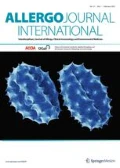Abstract
Background
Correct identification of the Hymenoptera that was responsible for stinging a patient is crucial when establishing the indication for specific immunotherapy (SIT) using Hymenoptera venom immunotherapy (VIT), advising the patient on allergen avoidance, and in terms evaluating accidental stings or sting challenges during VIT. There are around 15 species of social bees and wasps that most frequently cause stings in Central Europe. Even lay people are normally able to correctly classify causal insects into their respective families, i. e., Apidae or Vespidae. On the other hand, a more precise taxonomic classification and distinction within the subfamily and the genus is often imprecise or incorrect; for example, within the family Apidae (true bees), Apis (honeybees) is often mistaken for Bombus (bumblebees), while within the family Vespidae (folded-winged wasps), there is confusion between Polistes (paper wasps), Vespa (hornets), Dolichovespula (yellow jackets, long-cheeked wasps), and Vespula (yellow jackets, short-cheeked wasps).
Results
The morphological characters used for the typing of relevant genera are described and illustrated. A redetermination of wasps used at university hospitals for sting challenge tests revealed that 7% did not belong to the desired genus Vespula, but mainly to Dolichovespula instead. However, sting challenge tests using Dolichovespula species elicit approximately the same percentage of systemic allergic reactions as do Vespula stings.
Conclusion
With training, even nonentomologists are able to distinguish between taxa using simple techniques. The fact that a similar number of systemic allergic reactions are seen with sting challenge tests using Dolichovespula as with challenge tests using Vespula may be due to the high allergen affinity between the venoms. Another possible explanation for this could be that allergic reactions are more commonly triggered by Dolichovespula venom compared with Vespula venom than originally assumed.




Similar content being viewed by others
Notes
The morphologically correct term is setae, since insect setae are not the same as mammal hairs. However, for the sake of easy comprehension, the term hair has been used throughout the text in place of seta.
The morphologically correct term is mesosoma, since among Aculeata the thorax is fused with the first abdominal segment to form a new body section, the mesosoma. The remaining part of the abdomen forms the metasoma or gaster.
References
Mauss V. Diversität, Vorkommen, Sammel- und Abwehrverhalten von potentiell Insektengift-Allergie auslösenden Bienen und Faltenwespen in Deutschland. Allergo J. 2003;12(Sonderheft 1):7–15.
Mauss V. Bionomie und Abwehrverhalten der in Deutschland vorkommenden allergologisch bedeutsamen Bienen und Faltenwespen. Hautarzt. 2008;59:184–93.
Archer ME. Vespine wasps of the world. Manchester: Siri Scientific Press; 2012.
Edwards R. Social wasps. East Grinstead: Rentokil Limited; 1980.
Kemper H, Döhring E. Die sozialen Faltenwespen Mitteleuropas. Berlin, Hamburg: Paul Parey; 1967.
Mauss V. Biologische Aspekte der Lebensweise und des antagonistischen Verhaltens aculeater Hymenopteren Mitteleuropas. Allergo J. 1993;2(Suppl. 2):57–9.
Mauss V. Hinweise zum Stichrisiko für Bienen- und Wespengiftallergiker in verschiedenen Urlaubsregionen. Hautarzt. 2014;65:770–4.
Ruëff F, Przybilla B, Müller U, Mosbech U. The sting challenge test in Hymenoptera venom allergy. Position paper of the Subcommittee on Insect Venom Allergy of the European Academy of Allergology and Clinical Immunology. Allergy. 1996;51:216–25.
Ruëff F, Przybilla B. Stichprovokation: Indikation und Durchführung. Hautarzt. 2014;65:796–801.
Müller U, Berchtold E, Helbling A. Honeybee venom allergy: results of a sting challenge 1 year after stopping successful venom immunotherapy in 86 patients. J Allergy Clin Immunol. 1991;87:702–9.
Mauss V. Bestimmungsschlüssel für Hummeln, 4th ed. Hamburg: Deutscher Jugendbund für Naturbeobachtung; 1992.
Prosi R, Mauss V, Kämpf R. Bestimmungstafeln für die Hummeln Baden-Württembergs. Crailsheim: Eigenverlag; 2015.
Mauss V, Treiber R. Bestimmungsschlüssel für die Faltenwespen (Hymenoptera: Masarinae, Polistinae, Vespinae) der Bundesrepublik Deutschland, 3rd ed. Hamburg: Deutscher Jugendbund für Naturbeobachtung; 2004.
Witt R. Wespen, 2nd ed. Oldenburg: Vademecum; 2009.
Author information
Authors and Affiliations
Corresponding author
Ethics declarations
Conflict of interest
V. Mauss and F. Ruëff declare that they have no competing interests.
Rights and permissions
About this article
Cite this article
Mauss, V., Ruëff, F. Identification of bee and wasp taxa relevant in systemic allergic reactions to Hymenoptera stings in Central Europe. Allergo J Int 26, 81–87 (2017). https://doi.org/10.1007/s40629-017-0019-x
Received:
Accepted:
Published:
Issue Date:
DOI: https://doi.org/10.1007/s40629-017-0019-x




